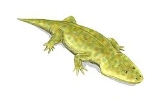
Metoposaurus
Encyclopedia
Metoposaurus is an extinct genus
of temnospondyl amphibian
, known from the Late Triassic
of Europe
. This mostly aquatic animal possessed small, weak limbs, had sharp teeth and a large flat head. The main diet of this highly flattened creature was fish
which it captured with its wide jaw
s lined with needle teeth. Metoposaurus was up to 3 m (10 feet) long, weighed 454 kg (1,000 pounds), and was one of the last large amphibians. Still, the much larger Koolasuchus
survived far into the Cretaceous
. A lot of Metoposaurus mass graves have been found, probably from creatures that grouped together in drying pools during drought
.
. It was also shown in a book version of Walking with Dinosaurs
.
Genus
In biology, a genus is a low-level taxonomic rank used in the biological classification of living and fossil organisms, which is an example of definition by genus and differentia...
of temnospondyl amphibian
Amphibian
Amphibians , are a class of vertebrate animals including animals such as toads, frogs, caecilians, and salamanders. They are characterized as non-amniote ectothermic tetrapods...
, known from the Late Triassic
Late Triassic
The Late Triassic is in the geologic timescale the third and final of three epochs of the Triassic period. The corresponding series is known as the Upper Triassic. In the past it was sometimes called the Keuper, after a German lithostratigraphic group that has a roughly corresponding age...
of Europe
Europe
Europe is, by convention, one of the world's seven continents. Comprising the westernmost peninsula of Eurasia, Europe is generally 'divided' from Asia to its east by the watershed divides of the Ural and Caucasus Mountains, the Ural River, the Caspian and Black Seas, and the waterways connecting...
. This mostly aquatic animal possessed small, weak limbs, had sharp teeth and a large flat head. The main diet of this highly flattened creature was fish
Fish
Fish are a paraphyletic group of organisms that consist of all gill-bearing aquatic vertebrate animals that lack limbs with digits. Included in this definition are the living hagfish, lampreys, and cartilaginous and bony fish, as well as various extinct related groups...
which it captured with its wide jaw
Jaw
The jaw is any opposable articulated structure at the entrance of the mouth, typically used for grasping and manipulating food. The term jaws is also broadly applied to the whole of the structures constituting the vault of the mouth and serving to open and close it and is part of the body plan of...
s lined with needle teeth. Metoposaurus was up to 3 m (10 feet) long, weighed 454 kg (1,000 pounds), and was one of the last large amphibians. Still, the much larger Koolasuchus
Koolasuchus
Koolasuchus is an extinct genus of brachyopoid temnospondyl in the family Chigutisauridae. Fossils have been found from Victoria, Australia and date back 120 Ma to the Aptian stage of the Early Cretaceous. Koolasuchus is the latest known temnospondyl. Koolasuchus is known from several fragments of...
survived far into the Cretaceous
Cretaceous
The Cretaceous , derived from the Latin "creta" , usually abbreviated K for its German translation Kreide , is a geologic period and system from circa to million years ago. In the geologic timescale, the Cretaceous follows the Jurassic period and is followed by the Paleogene period of the...
. A lot of Metoposaurus mass graves have been found, probably from creatures that grouped together in drying pools during drought
Drought
A drought is an extended period of months or years when a region notes a deficiency in its water supply. Generally, this occurs when a region receives consistently below average precipitation. It can have a substantial impact on the ecosystem and agriculture of the affected region...
.
In Popular Culture
Metoposaurus was shown in the "Dawn of the Dinos" episode of PaleoworldPaleoworld
Paleoworld was a documentary television series that was produced for The Learning Channel, and has had a total of 50 episodes. Some consider it to be the largest and most comprehensive paleontology series ever made. The series began in late September 1994 and, after 4 seasons, ended in 1997...
. It was also shown in a book version of Walking with Dinosaurs
Walking with Dinosaurs
Walking with Dinosaurs is a six-part documentary television miniseries that was produced by BBC, narrated by Kenneth Branagh, and first aired in the United Kingdom, in 1999. The series was subsequently aired in North America on the Discovery Channel in 2000, with Branagh's voice replaced with that...
.

